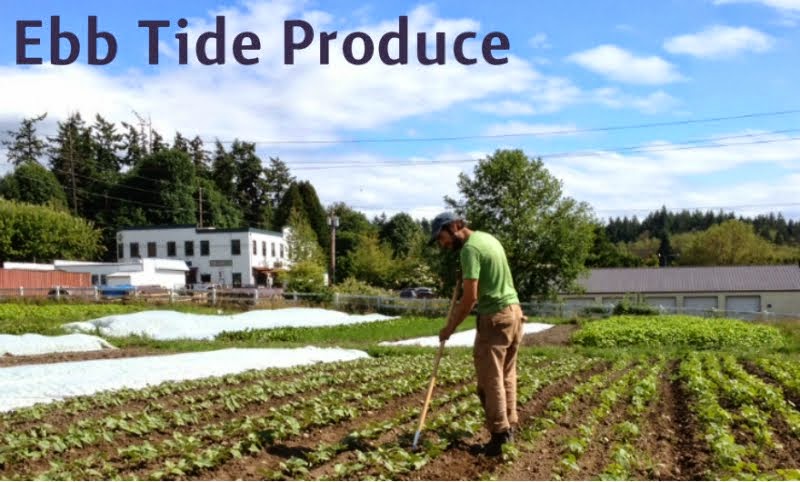Last August share...
In all shares:
Sweet corn- Sweet corn is a grass...a very strange grass cultivated in complex and amazing ways by the Southwest American Indians to produce its large cobs. The last few years of intensive modern breeding have led to much, much sweeter varieties of corn that no longer need to be cooked to be sweet and tender...lots of older recipes call for cooking corn for much longer than is necessary with modern varieties. These modern hybrids shouldn't be confused with GMO -genetically modified- corn, which is primarily in field corn and not as far as I know in sweet corn as of yet...although it's probably only a matter of time. Unlike genetic modification, hybridized crops have existed for decades and are merely the result of crossing two different varieties....in the case of sweet corn, the pollen from the tassels of the "male" plants fertilize the silks of the "female" cobs of a different corn variety.
Tomatoes- Unlike sweet corn, which modern breeding has arguably improved, modern science seems to only be interested in producing watery and flavorless supermarket tomatoes. Most of the tomatoes we grow on the farm are "heirlooms", meaning they are not hybrids, and existed before the middle of the last century when hybridization really took off. Heirloom tomatoes tend to have much better flavor, but have a shorter storage life, less disease resistance and oftentimes look a little funny as they are less cosmetically uniform.
Green beans- Beans are the third crop here that we have courtesy of American Indians, and along with corn and squash were the "three sisters" that made up a large part of the Southwest Indian diet. Beans are in the legume family along with peas, lentils, clover, alfalfa, and peanuts...all these crops are able to "fix" nitrogen in the soil, meaning they have root nodules that house bacteria that are able to take nitrogen out of the air and transform it into a form that the plants can use. Nitrogen is a primary nutrient for plants, and so legumes have long been used to restore the fertility of nitrogen depleted soils.
Carrots- Finally a crop from the old world...carrots are in the family Umbelliferae, meaning umbrella like for the shape of their seed head. This family includes a lot of herbs and aromatic vegetables, like celery, parsnip, fennel, parsley, coriander/cilantro, dill, cumin, and many more. They were cultivated from wild carrots that grow throughout Europe and west Asia, probably first in the Middle East.
Walla walla onions- Technically, it is illegal for me to call these Walla walla onions, as the city of Walla Walla, Washington has gotten a legal Appellation, much like the champagne region of France, which means that only onions grown within a certain area can be marketed as Walla wallas...but it is also the name of the variety that I grow, and rather that call them "sweet yellow onions of the Walla walla type" it is easier to just use the shorthand and hope their lawyers aren't reading my farm blog!
Parsley- As mentioned above, parsley is in the same family as carrots, and makes a great fresh herb garnish to finish a meal.
In large shares:
Sweet pepper- Another Southwestern crop, of course, sweet peppers and hot peppers are basically the same species, but bred for different levels of the capsaicin, the compound that gives chili peppers their heat. These sweet peppers have basically none, but a great crunch and sweet flavor. Our peppers usually produce until the beginning of November, so they will be a regular in the second half of the farm share hopefully!
Summer squash- The third of the three sisters, although my understanding is that the Indians were primarily growing more what we would think of as Winter squash as a storage crop. Much like with the peppers, Summer and Winter squash are the exact same species, with different varieties just bred for different purposes; Summer squash for mild, juicy fruits produced over a long period in the Summer, and Winter squash bred to produce fewer but larger and much more nutrient dense fruits which can be stored and eaten through the Fall and Winter.
Garlic- Our garlic is all cut down and looking beautiful. Garlic is in the Allium family, along with onions, shallots, and leeks, but it is the only allium that we grow as a biennial in our climate, meaning we plant it in the Fall and don't harvest it until the following Summer. We will be getting ready to plant garlic soon, separating our own seed garlic from the garlic we can sell or give to you.
Summer keeps trucking along, although it's back to school season now, farming goes more by the true seasonal schedule, with Summer lasting until late September. That said, some Fall crops will be starting to appear in the shares over the coming weeks. Thanks!
Subscribe to:
Post Comments (Atom)

No comments:
Post a Comment